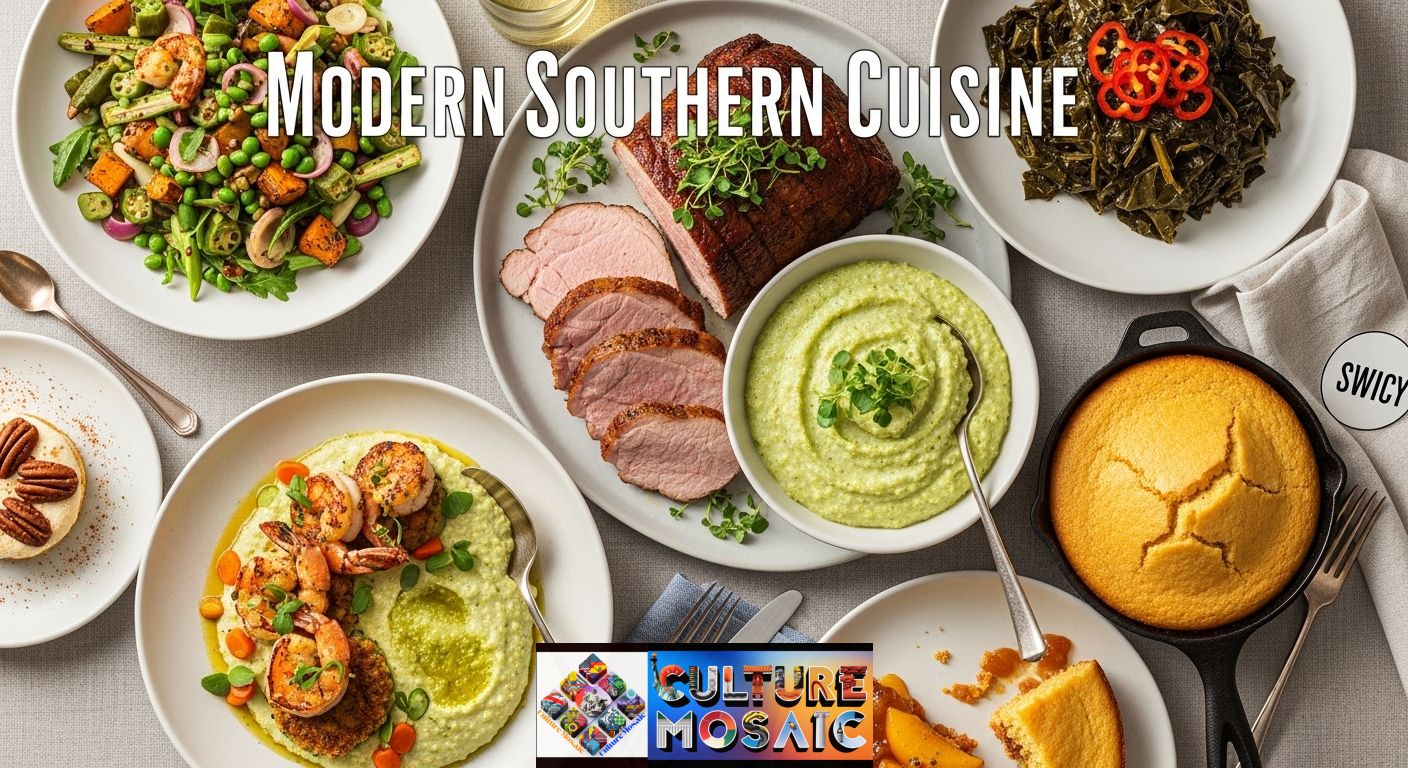The South has always possessed a rich history to be told through food. From the smoky temptation of Carolina barbecue to the creamy solace of shrimp and grits, modern Southern cuisine is more than mere fuel for the body—it’s living history, family, and place. Yet something great is occurring in kitchens throughout the region. Chefs and cooks at home are reinventing these traditions, crafting what we now honor as modern Southern cuisine.
This transformation isn’t about abandoning the past; instead, it’s about honoring traditional recipes while updating them for contemporary tastes. Modern Southern cuisine combines traditional cooking techniques, seasonal ingredients, a focus on health, and unique global influences to create dishes that feel both familiar and refreshingly new.
What Defines Modern Southern Cuisine?
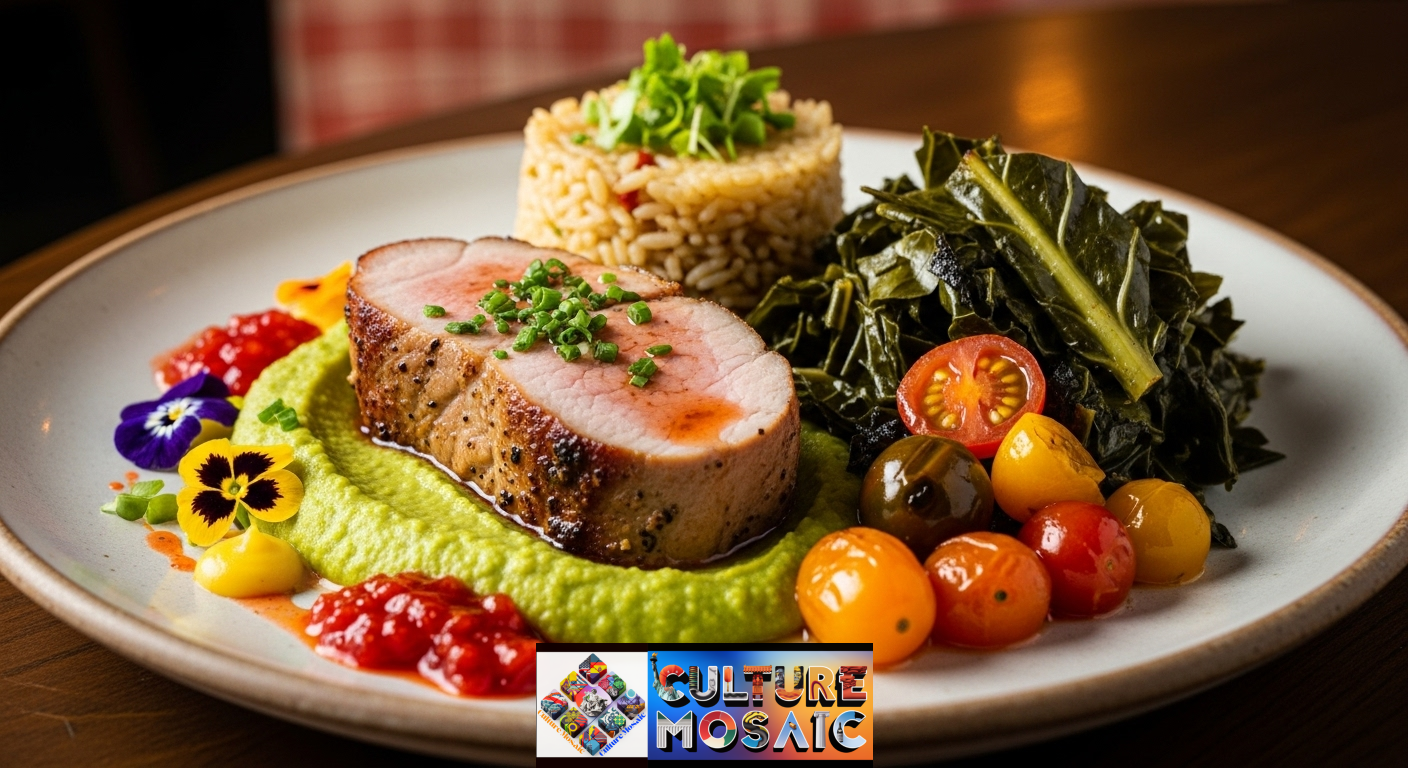
Contemporary Southern food is a considered evolution of the old foodways. At its core are the recipes and methods handed down through the generations—the slow-cooked greens, the ideally seasoned cast-iron cornbread, the low-and-slow art of smoking meat. These are still revered as the foundational elements.
What sets apart Southern cuisine today is an openness to experimentation within it. modern Southern cuisine are lightening old recipes without diminishing flavor, giving vegetables star roles instead of secondary ones, and finding inspiration in the global ingredients that underscore the modern-day diverse Southern population.
The movement also calls for transparency regarding sourcing. Contemporary Southern cooking honors local farmers, heirloom crops, and sustainable methods. There is a renewed focus on virtually forgotten ingredients such as Sea Island red peas, Carolina Gold rice, and heritage breed pork that previously characterized regional cooking.
This strategy recognizes that Southern cuisine has always been an exercise in adaptation. The cuisine itself was the result of融合 African, Native American, European, and Caribbean influences. Contemporary Southern cuisine merely maintains this pattern of creative exchange.
The Cultural Roots: Lowcountry, Appalachian, and Creole Traditions
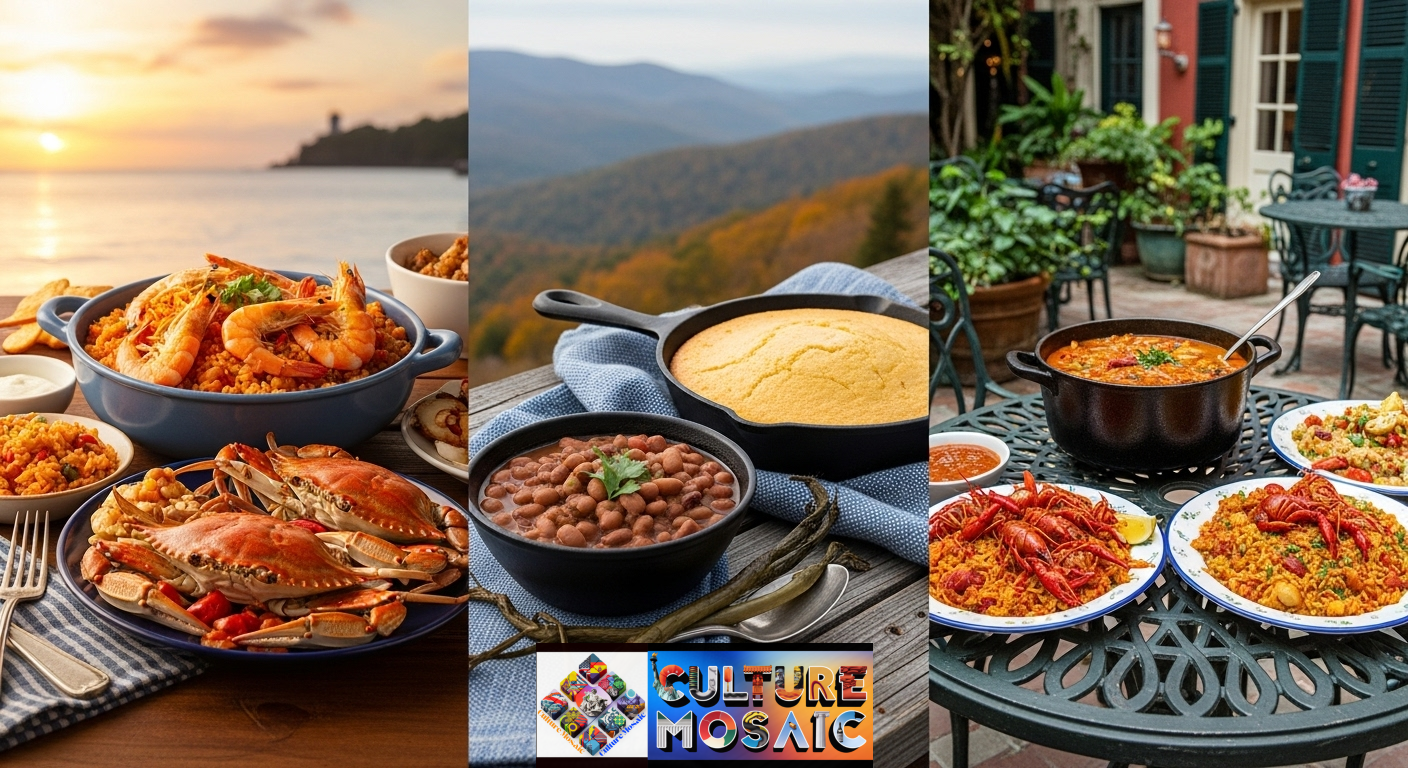
To understand contemporary Southern cuisine is to appreciate the unique regional traditions that inform it. The South is not a culinary monolith—it’s a mosaic of microclimates, histories, and cultural influences.
Lowcountry Heritage
The Lowcountry area, running along the shores of South Carolina and Georgia, constructed its cuisine based on rice farming and bountiful seafood. Gullah Geechee settlements maintained West African culinary methods that still form the basis of the region’s culture. Foods such as red rice, she-crab soup, and Frogmore stew highlight the region’s seafood abundance.
Contemporary takes on Lowcountry food tend to emphasize the refined rice culture that previously established Charleston as a gastronomic hub. Chefs are rediscovering heirloom rice types and showing grains the same respect usually used to define proteins.
Appalachian Simplicity
Mountain cuisine of the Appalachian variety is all about preservation, gathering, and using what’s present. Cornbread, pinto beans, ramps, and salted pork were staples of mountain tables.
Appalachian-inspired Southern cuisine of today honors such resourcefulness. Chefs are revisiting fermentation, featuring foraged foods, and turning simple beans and greens into fine dining fare.
Creole Complexity
Louisiana’s Creole heritage is likely the most cosmopolitan variety of Southern food. The culinary traditions of France, and the Native Americans blended to produce dishes of unparalleled sophistication—gumbo, étouffée, and jambalaya, to name a few.
Contemporary Southern cuisine owes a great debt to this tradition of layering and complexity, extending Creole concepts to new ingredients.
Plant-Forward Approaches in Modern Southern Cuisine
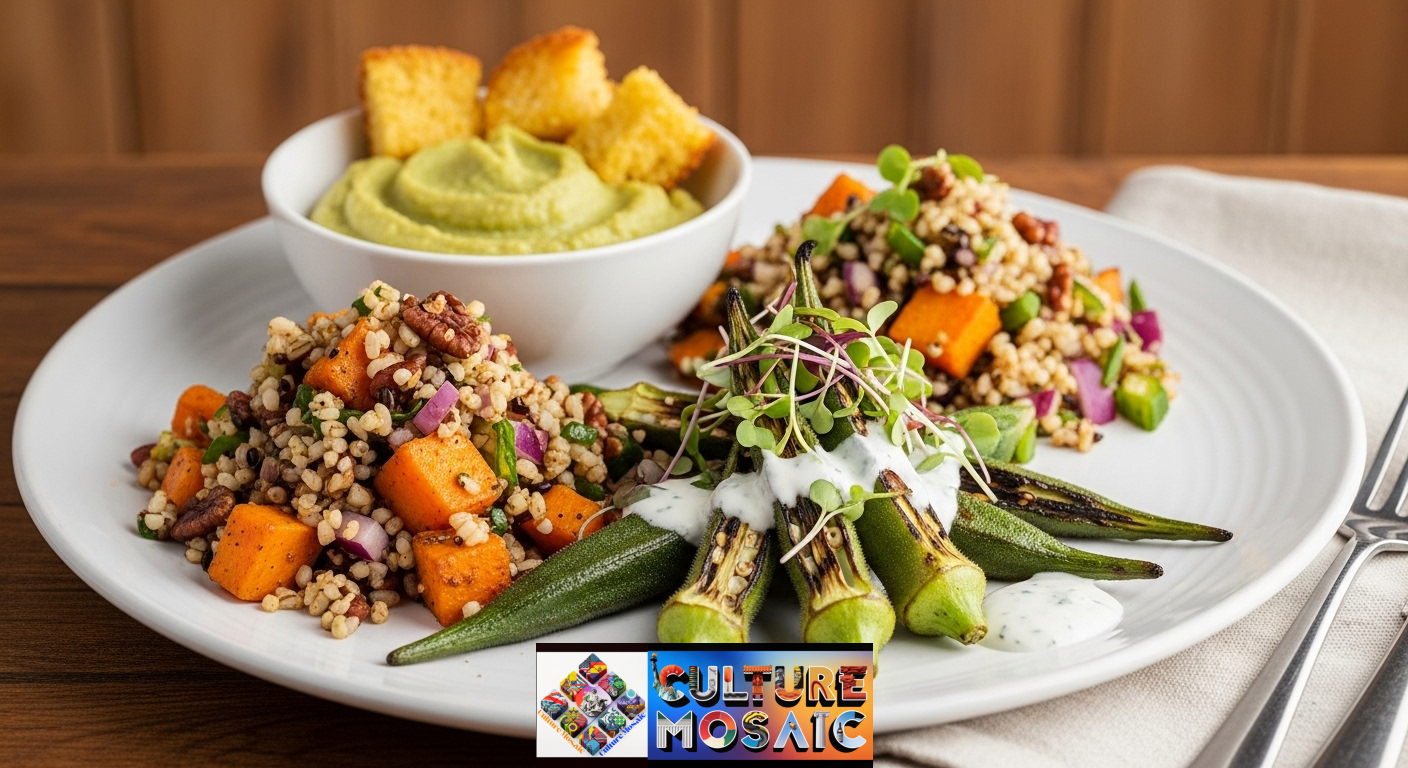
Perhaps the most important change in contemporary Southern cuisine is the role of vegetables being elevated from the margins to the main event. This doesn’t necessitate eliminating meat—porkless Southern cuisine would be almost unimaginable—but more awarding vegetables the respect they are due.
Traditional Southern cuisine really does provide a rich source of plant-based inspiration. Field peas, butter beans, collard greens, okra, sweet potatoes, and corn constituted the dietarily sound bedrock of Southern tables decades before modern-day dietary fads were born.
Gourmet Southern cooks are emphasizing these ingredients in novel ways. Burnt okra is elevated to refined appetizer form by buttermilk dressing. Sweet potato assumes international spices in creative side dishes. Butter beans are pureed into rich spreads or featured in refined salads.
This plant-based revolution also relates to the revival of ancestral grains. Grits, previously eschewed as poor people’s food, now turn up on high-end menus milled from heritage corn varieties. Carolina Gold rice, all but lost a generation ago, has been carefully revitalized and now fetches premium prices.
The elegance of this process is its sincerity. Contemporary Southern cooking doesn’t dictate plant-based cuisine as some foreign imposition—it merely unearths and celebrates the vegetable-based traditions that were already inherent within Southern cooking.
Global Flavors Meet Southern Traditions
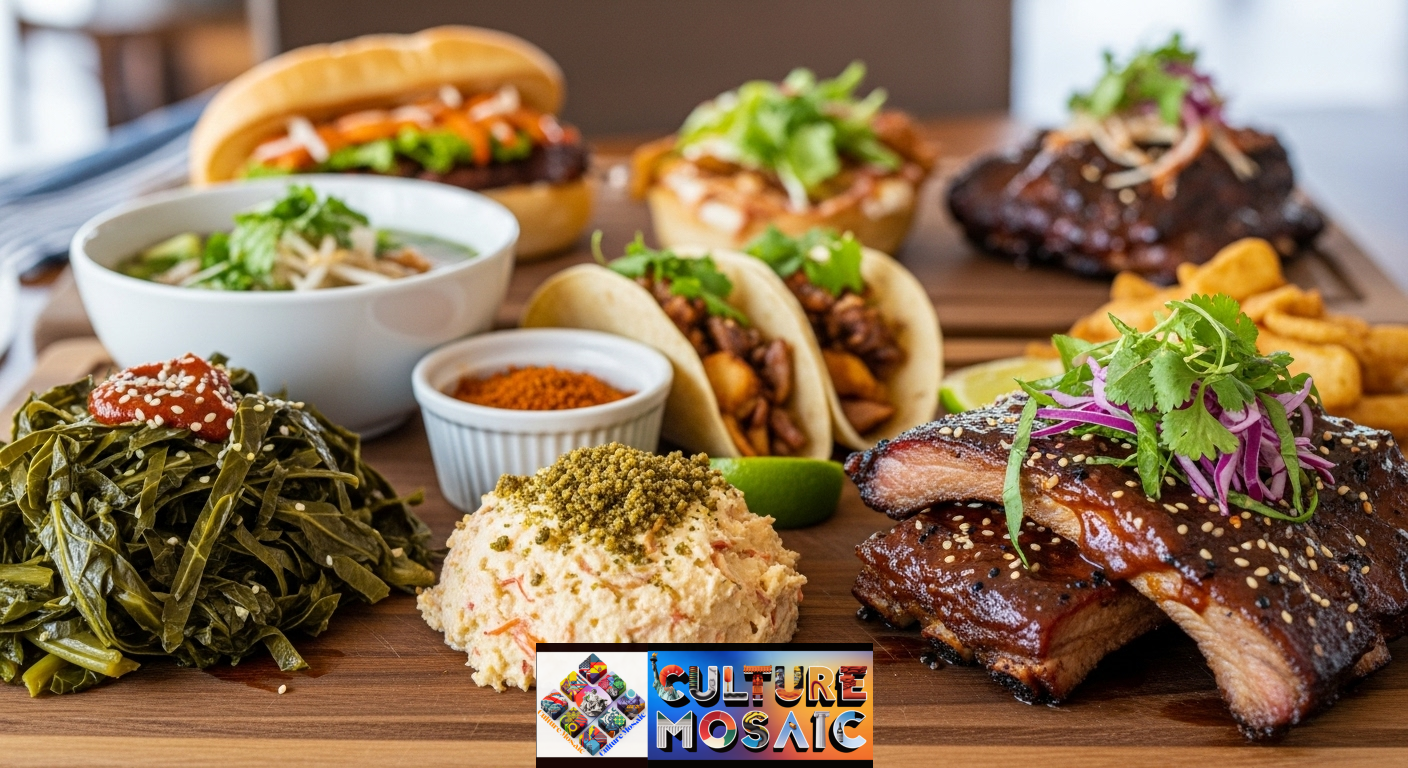
The South has never been as monolithic as popular fantasy. Contemporary Southern cuisine makes this multivalence explicit, with international flavors that speak to contemporary Southern society and respect classic methods.
Korean gochujang brings its own heat and depth to collard greens. Harissa or za’atar ennoble pimento cheese. Barbecue sauces add tamarind, fish sauce, or miso for unanticipated umami richness.
These are not arbitrary mixtures for novelty’s sake. They are an expression of the real composition of the South’s population today and how immigrant groups have integrated their culinary traditions into regional patterns. Vietnamese restaurants in Houston and New Orleans serve po’boys with pho. Mexican taquerías in North Carolina use local barbecue practices.
Contemporary Southern cuisine celebrates this fact, crafting dishes that pay tribute to several threads of heritage at once. The outcome is at once innovative and inevitable—a harmonious extension of the South’s centuries-long tradition of cross-pollination on the plate.
The Rise of Swicy Flavors in Southern Desserts
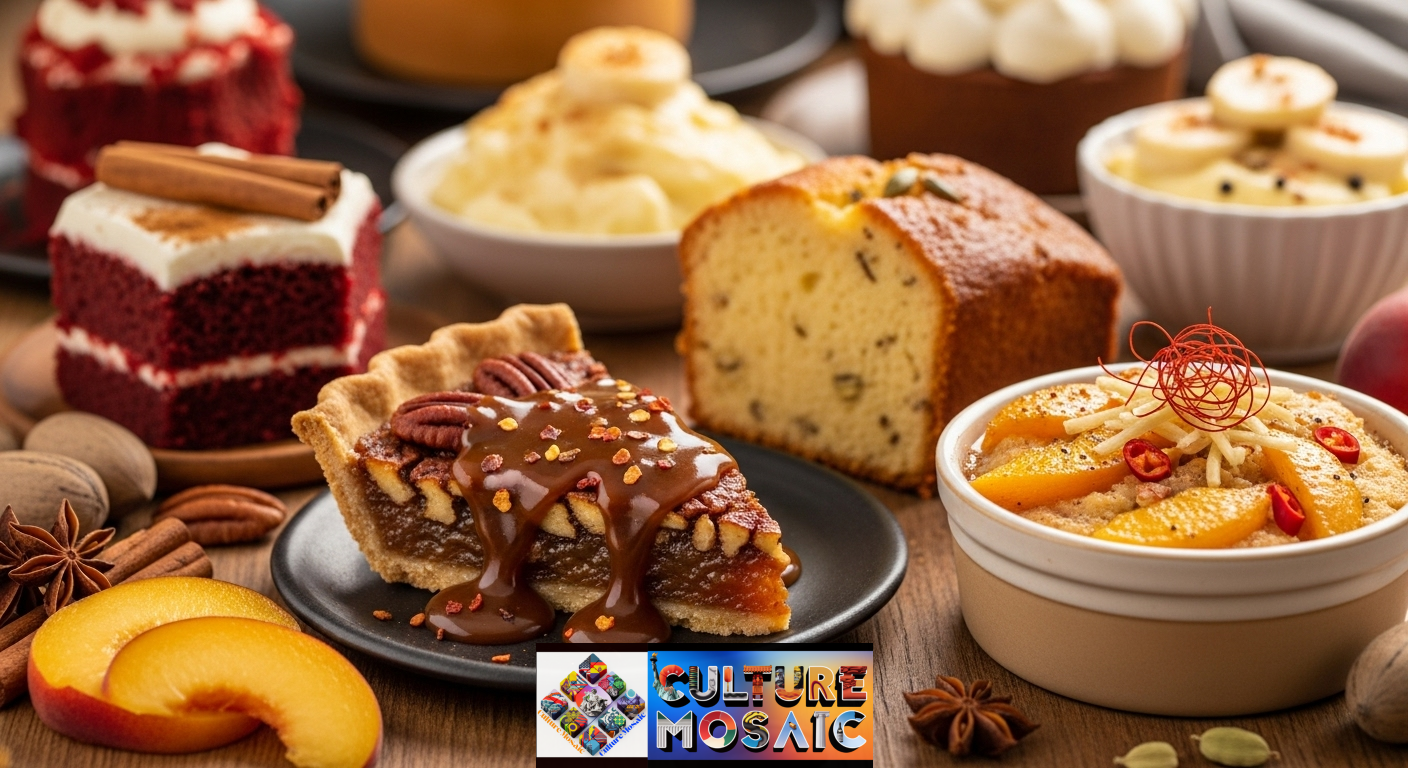
One of the most whimsical trends in contemporary Southern cooking is the rise of “swicy” sweet and spicy flavor combinations in sweets. Southern sweets always tipped rich and decadent: pecan pie, red velvet cake, banana pudding. Today’s pastry chefs are spicing up these classics with unexpected heat and spice.
Pecan pie is topped with cayenne-spiced caramel. Pound cake contains cardamom and black pepper. Peach cobbler has ginger and chili-infused syrup. The extra ingredients do not overwhelm the basic sweetness of the desserts but increase their complexity and appeal.
This trend ties into larger movements in modern baking but is rooted in Southern traditions. Spice cakes and gingerbread, after all, have long been staples of the repertoire. It’s just that newer Southern cuisine takes those pairing up a notch, crafting desserts that surprise and please in equal proportion.
Culinary Upcycling and Zero-Waste Techniques
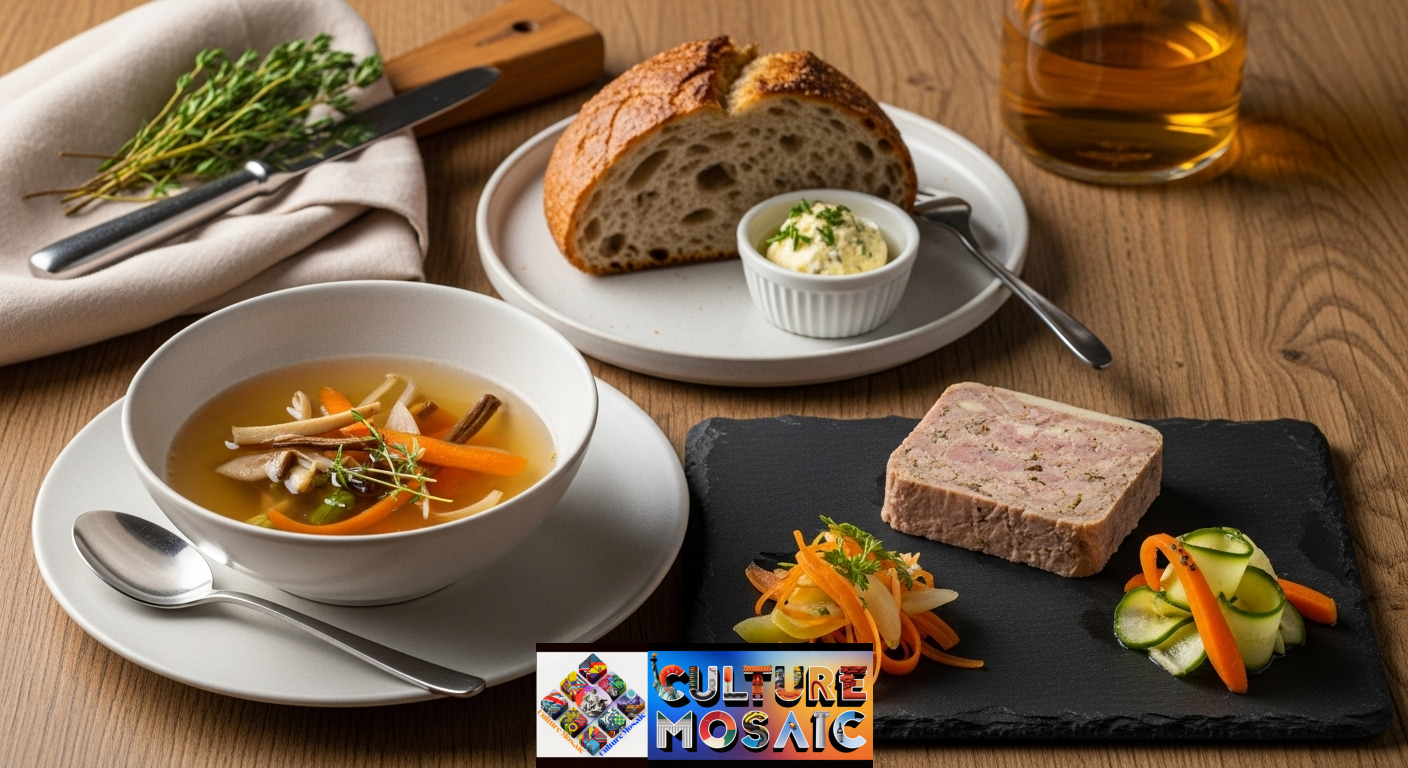
Contemporary Southern food has taken food upcycling to heart. This is not surprising, considering the South’s long tradition of utilizing all parts of an ingredient.
Traditional Southern cuisine was a frugal cuisine. Nothing was wasted. Pot liquor, which was the nutrient-rich liquid remaining from boiling greens, served as the foundation for soups or gravy. Stale cornbread was reborn as dressing. Meat trimmings became sausage or scrapple.
Modern chefs are implementing this philosophy with greater imagination. Vegetable peels are turned into refined broths. Brewer’s spent grains are incorporated into breads. Meat trim that otherwise would have gone to waste turns into terrines or rillettes.
This strategy appeals to consumers who care about sustainability but also want to connect with the true Southern foodways. It shows that contemporary Southern cooking isn’t about leaving tradition in favor of trends—it’s about knowing tradition deeply enough to innovate its principals.
From Home Kitchens to Fine Dining
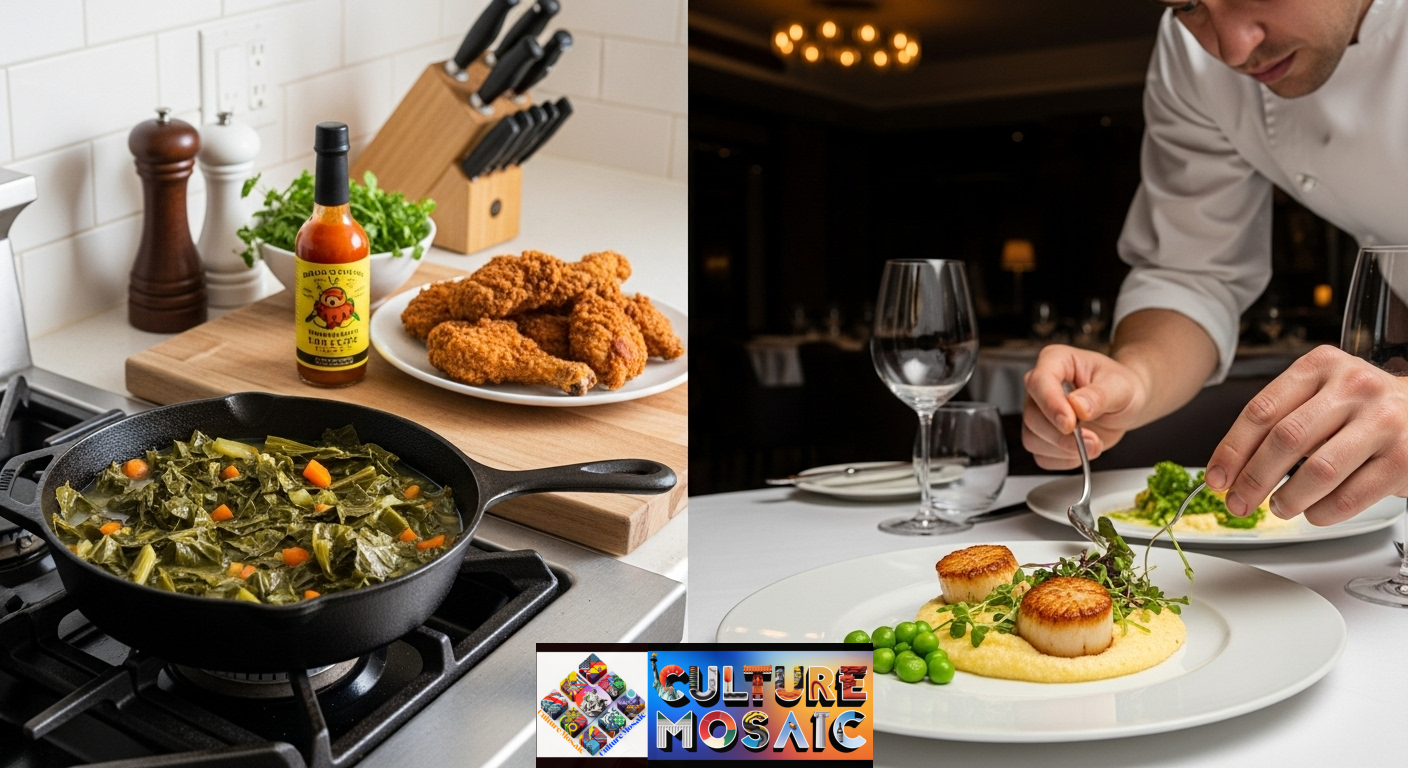
Contemporary Southern food is on a continuum from humble comfort to refined polish. Whatever its level, the common thread is devotion to good ingredients and deferential treatment.
At the home cook level, contemporary Southern cooking can translate to cooking collard greens with vegetable broth rather than ham hocks, or trying out global hot sauces on fried chicken. It’s about upholding the essence of Southern hospitality and updating recipes to fit modern ways of life and food habits.
In restaurants, contemporary Southern food has promoted regional cuisine to haute cuisine. Chefs trained classically are using French methods to prepare Lowcountry seafood or serving Appalachian produce with the flair of haute cuisine.
This range showcases the versatility of Southern ingredients and methods. The same heritage cornmeal used to make a humble breakfast can be transformed into a refined polenta course. Field peas do just as well in an unpretentious weeknight supper as in a tasting menu.
Regional Spotlights: Beyond the Usual Suspects
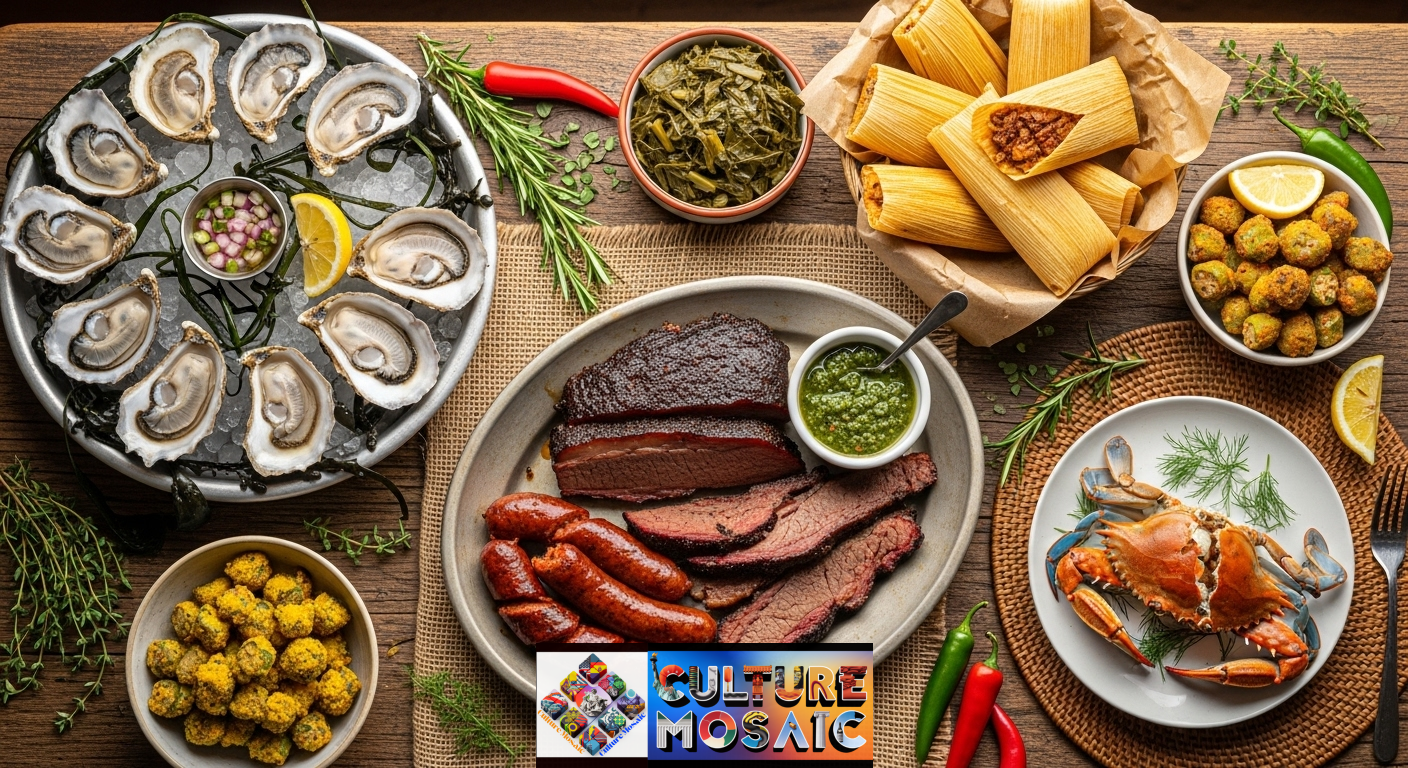
While towns such as Charleston, Nashville, and New Orleans deserve accolades for their roles in the evolution of modern Southern cuisine, the movement goes far beyond these dining hubs.
Texas Innovation
Texas ‘cue keeps innovating beyond brisket. Pitmasters are trying new types of wood, international marinades, and surprising proteins. Texas’s location next to Mexico guarantees ongoing cross-pollination between Tex-Mex and old-school Southern barbecue traditions.
Mississippi Delta Soul Food
The Delta area is seeing a low-key renaissance as chefs revive the region’s deep African American culinary roots. Hot tamales, the local dish, are receiving upscale attention. Classic soul food eateries are highlighting farm-to-table practices.
Virginia Tidewater Revival
Virginia’s coastal areas are reclaiming their culinary past, highlighting oysters, blue crabs, and the native crops that sustained early settlements. Contemporary Southern cuisine here highlights the region’s colonial past as well as its modern Southern cuisine.
Health-Conscious Adaptations Without Compromise
Adapting traditionally rich dishes to modern health consciousness is one challenge to modern Southern cuisine. Southern food’s image as heavy, fried offerings can overwhelm its healthier aspects.
New Southern chefs are discovering how to make dishes lighter while still retaining their vital essence. Greens may be sautéed with smoked turkey rather than fatback. Cornbread is prepared with whole grain flour. Frying occurs in healthier oils at appropriate temperatures.
The secret is knowing what makes a dish truly “Southern.” Sometimes it’s the seasoning, sometimes the method, or sometimes the mix of ingredients more than the amount of fat or salt. Knowing these building blocks, contemporary Southern cuisine can be as satisfying without being as nutritionally unbalanced.
This isn’t to say every recipe has to be altered. One of the draws of modern Southern cuisine is knowing when tradition is best left alone. A good biscuit takes the correct proportion of fat to flour. Some things shouldn’t be “fixed.”
The Role of Storytelling in Modern Southern Cuisine
Modern Southern cuisine has never been separable from narrative. Every dish holds history—the cook who mastered it, the occasion to which it is owed, the community to which it belongs. Modern Southern cuisine celebrates this narrative aspect openly.
Restaurants now reveal the origin of their ingredients and the inspiration for their dishes. Cookbooks contain family histories in addition to recipes. Chefs acknowledge the grandmothers, mentors, and communities that influenced their cooking.
This narrative is not just advertising. It is a sincere attempt to maintain cultural heritage and pay tribute to the individuals—usually unknown and unsung—who developed and kept alive Southern foodways. New Southern cuisine understands that you can’t disconnect the food from the background without losing something integral.
For home cooks and diners, these accounts provide additional levels of connection to the food. Knowing that a specific field pea preparation draws on Gullah Geechee heritage or that a given cornbread recipe symbolizes Appalachian frugality makes the act of eating more meaningful.
Preserving Heritage While Embracing Change
The conflict at the core of contemporary Southern cooking is sustaining heritage while opening itself to evolution. Both reverence and courage are needed to balance these aspects.
Reverence is studying traditional methods correctly, knowing why those particular methods succeed, and honoring the cultural contexts that built Southern food. It is not dismissing older preparation as unsophisticated simply because they are new to you.
Courage is being willing to try things, to include new influences, and to believe that cuisine has always changed. It is realizing that “traditional” Southern food itself is centuries of adaptation and exchange.
The most effective modern Southern cuisine achieves this balance. It shows strong understanding of tradition without letting itself be bound by it. The result is both grounded and evolving—irresistibly Southern but completely now.
Looking Forward: The Future of Modern Southern Cuisine
Modern Southern cuisine keeps developing as new voices join the discussion. Young chefs introduce new ideas while older traditions are rediscovered and recorded before being lost forever.
Climate change will also affect ingredient availability and seasons, testing the creativity of Southern cooks to come up with new recipes. The growing diversity of the South will bring new combinations of flavors and methods. Technology will provide new strategies to preserve and disseminate culinary knowledge.
During these transitions, the basic principles that characterize modern Southern cuisine—respect for ingredients, place connection, openness to influence, and commitment to community—will probably persist. These values are more than particular dishes or cooking methods, giving an outline for ongoing change.
The future likely includes even more overt recognition of the African, African American, and Indigenous cooks whose work was previously downplayed. Contemporary Southern cooking has the chance to share fuller, more truthful narratives about who prepared these popular dishes and under what conditions.
Frequently Asked Questions About Modern Southern Cuisine
What is different in modern Southern cuisine compared to traditional Southern food?
Contemporary modern Southern cuisine remains true to traditional methods and flavor profiles but includes modern influences such as international spices, plant-based styles, and health-oriented preparations. It honors tradition but permits innovation and adaptation for modern tastes and dietary needs.
Is modern Southern cuisine restaurant-exclusive or can be prepared at home?
You can absolutely create modern Southern cuisine at home. The approach is more about mindset than expensive ingredients or equipment. Try using traditional Southern recipes as a starting point, then experiment with lighter cooking methods, incorporate more vegetables, or add global seasonings that appeal to you.
How does modern Southern cuisine address dietary restrictions?
Contemporary Southern food provides flexibility for many different dietary requirements without compromising on true flavors. Most of the classic Southern foods are inherently vegetarian or can be made over—consider collard greens, butter beans, and field peas. Chefs are discovering innovative substitutes that do the spirit of dishes justice while satisfying vegetarian, vegan, or gluten-free requirements.
What are some of the key ingredients in contemporary Southern food?
Heritage ingredients such as Carolina Gold rice and heirloom cornmeal, in-season vegetables such as okra and collard greens, field peas and butter beans, high-quality pork products, freshly caught seafood in coastal areas, and a fully stocked spice rack with both traditional and international seasonings. Locally sourced and sustainable when available.
Which cities would I visit to find the greatest modern Southern cuisine?
Although Charleston, Nashville, and New Orleans are still culinary attractions, contemporary Southern cooking thrives across the region. Try Atlanta, Durham, Houston, Birmingham, Richmond, and Memphis. Small towns and the countryside frequently conceal great restaurants preserving local traditions with innovative flair.

